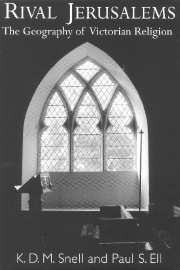Book contents
- Frontmatter
- Contents
- List of figures
- List of tables
- Preface and acknowledgements
- Introduction
- Part 1 Religious geographies: the districts of England and Wales
- 1 The 1851 Census of Religious Worship
- 2 The Church of England
- 3 Old dissent: the Presbyterians, Independents, Baptists, Quakers and Unitarians
- 4 The geographies of new dissent
- 5 Roman Catholicism and Irish immigration
- 6 Denominational co-existence, reciprocity or exclusion?
- Part 2 Religion and locality: parish-level explorations
- Technical appendices
- Bibliography
- Index
6 - Denominational co-existence, reciprocity or exclusion?
Published online by Cambridge University Press: 08 August 2009
- Frontmatter
- Contents
- List of figures
- List of tables
- Preface and acknowledgements
- Introduction
- Part 1 Religious geographies: the districts of England and Wales
- 1 The 1851 Census of Religious Worship
- 2 The Church of England
- 3 Old dissent: the Presbyterians, Independents, Baptists, Quakers and Unitarians
- 4 The geographies of new dissent
- 5 Roman Catholicism and Irish immigration
- 6 Denominational co-existence, reciprocity or exclusion?
- Part 2 Religion and locality: parish-level explorations
- Technical appendices
- Bibliography
- Index
Summary
Introducing the historiography
This chapter aims to resolve certain long-standing debates about the regional reciprocity or proximity of the major denominations. Some of the most widely found and important hypotheses in nineteenth-century religious historiography have been concerned with how Wesleyan Methodism and its various offshoots were related to the strengths and weaknesses of the Church of England, and secondly to the regional presence of the old dissenting denominations. The conclusions reached on these matters have a number of significant implications for further issues, bearing as they do on religious rivalries and the reasons for denominational success or failure, the regional political influence of denominations, and the extent to which they acted in union with or in antagonism against each other. In handling such issues historians have adopted different regions for study, and varied units for analysis: sometimes the county, sometimes the registration district, occasionally the parish, or township. Some religious scholars have been vague about what units of analysis they are using, or indeed what regions they are discussing, and many have couched their arguments in rather impressionistic terms. The data and methods here allow some further understanding of these issues. For the purpose of this chapter, analysis will be of the registration-district data mapped earlier in this book, for this is best tailored to study the whole compass of Wales and England.
The major arguments to consider may be summarised.
- Type
- Chapter
- Information
- Rival JerusalemsThe Geography of Victorian Religion, pp. 185 - 198Publisher: Cambridge University PressPrint publication year: 2000



